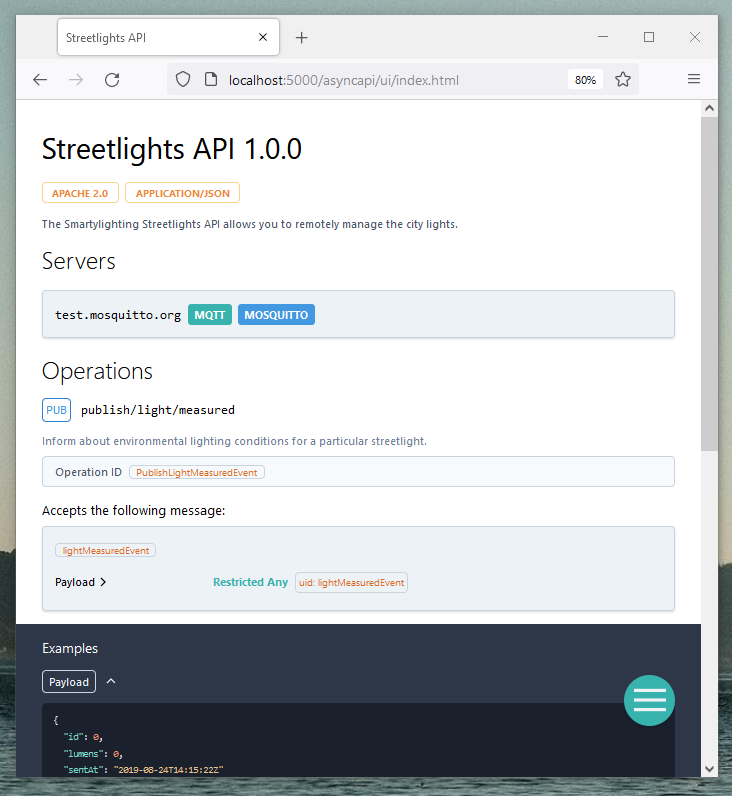Saunter is an AsyncAPI documentation generator for dotnet.
ℹ Note that pre version 1.0.0, the API is regarded as unstable and breaking changes may be introduced.
-
Install the Saunter package
dotnet add package Saunter -
In the
ConfigureServicesmethod ofStartup.cs, configure Saunter.// Add Saunter to the application services. services.AddAsyncApiSchemaGeneration(options => { // Specify example type(s) from assemblies to scan. options.AssemblyMarkerTypes = new[] {typeof(StreetlightMessageBus)}; // Build as much (or as little) of the AsyncApi document as you like. // Saunter will generate Channels, Operations, Messages, etc, but you // may want to specify Info here. options.AsyncApi = new AsyncApiDocument { Info = new Info("Streetlights API", "1.0.0") { Description = "The Smartylighting Streetlights API allows you\nto remotely manage the city lights.", License = new License("Apache 2.0") { Url = "https://www.apache.org/licenses/LICENSE-2.0" } }, Servers = { { "mosquitto", new Server("test.mosquitto.org", "mqtt") } } }; });
-
Add attributes to your classes which publish or subscribe to messages.
[AsyncApi] // Tells Saunter to scan this class. public class StreetlightMessageBus : IStreetlightMessageBus { [Channel("publish/light/measured")] // Creates a Channel [PublishOperation(typeof(LightMeasuredEvent), Summary = "Inform about environmental lighting conditions for a particular streetlight.")] // A simple Publish operation. public void PublishLightMeasuredEvent(Streetlight streetlight, int lumens) {}
-
Add saunter middleware to host the AsyncApi json document. In the
Configuremethod ofStartup.cs:app.UseEndpoints(endpoints => { endpoints.MapAsyncApiDocuments(); endpoints.MapAsyncApiUi(); });
-
Use the published AsyncApi document:
// HTTP GET /asyncapi/asyncapi.json { // Properties from Startup.cs "asyncapi": "2.1.0", "info": { "title": "Streetlights API", "version": "1.0.0", "description": "The Smartylighting Streetlights API allows you\nto remotely manage the city lights.", // ... }, // Properties generated from Attributes "channels": { "light/measured": { "publish": { "operationId": "PublishLightMeasuredEvent", "summary": "Inform about environmental lighting conditions for a particular streetlight.", //... }
-
Use the published AsyncAPI UI:
See the options source code for detailed info.
Common options are below:
services.AddAsyncApiSchemaGeneration(options =>
{
options.AssemblyMarkerTypes = new[] { typeof(Startup) }; // Tell Saunter where to scan for your classes.
options.AddChannelItemFilter<MyChannelItemFilter>(); // Dynamically update ChanelItems
options.AddOperationFilter<MyOperationFilter>(); // Dynamically update Operations
options.Middleware.Route = "/asyncapi/asyncapi.json"; // AsyncAPI JSON document URL
options.Middleware.UiBaseRoute = "/asyncapi/ui/"; // AsyncAPI UI URL
options.Middleware.UiTitle = "My AsyncAPI Documentation"; // AsyncAPI UI page title
}The JSON schema generation can be customized using the options.JsonSchemaGeneratorSettings. Saunter defaults to the popular camelCase naming strategy for both properties and types.
For example, setting to use PascalCase:
services.AddAsyncApiSchemaGeneration(options =>
{
options.JsonSchemaGeneratorSettings.TypeNameGenerator = new DefaultTypeNameGenerator();
// Note: need to assign a new JsonSerializerSettings, not just set the properties within it.
options.JsonSchemaGeneratorSettings.SerializerSettings = new JsonSerializerSettings
{
ContractResolver = new DefaultContractResolver(),
Formatting = Formatting.Indented;
};
}You have access to the full range of both NJsonSchema and JSON.NET settings to configure the JSON schema generation, including custom ContractResolvers.
Bindings are used to describe protocol specific information. These can be added to the AsyncAPI document and then applied to different components by setting the BindingsRef property in the relevant attributes [OperationAttribute], [MessageAttribute], [ChannelAttribute]
// Startup.cs
services.AddAsyncApiSchemaGeneration(options =>
{
options.AsyncApi = new AsyncApiDocument
{
Components =
{
ChannelBindings =
{
["my-amqp-binding"] = new ChannelBindings
{
Amqp = new AmqpChannelBinding
{
Is = AmqpChannelBindingIs.RoutingKey,
Exchange = new AmqpChannelBindingExchange
{
Name = "example-exchange",
VirtualHost = "/development"
}
}
}
}
}
}
});[Channel("light.measured", BindingsRef = "my-amqp-binding")] // Set the BindingsRef property
public void PublishLightMeasuredEvent(Streetlight streetlight, int lumens) {}Available bindings:
You can generate multiple AsyncAPI documents by using the ConfigureNamedAsyncApi extension method.
// Startup.cs
// Add Saunter to the application services.
services.AddAsyncApiSchemaGeneration(options =>
{
// Specify example type(s) from assemblies to scan.
options.AssemblyMarkerTypes = new[] {typeof(FooMessageBus)};
}
// Configure one or more named AsyncAPI documents
services.ConfigureNamedAsyncApi("Foo", asyncApi =>
{
asyncApi.Info = new Info("Foo API", "1.0.0");
// ...
});
services.ConfigureNamedAsyncApi("Bar", asyncApi =>
{
asyncApi.Info = new Info("Bar API", "1.0.0");
// ...
});Classes need to be decorated with the AsyncApiAttribute specifying the name of the AsyncAPI document.
[AsyncApi("Foo")]
public class FooMessageBus
{
// Any channels defined in this class will be added to the "Foo" document
}
[AsyncApi("Bar")]
public class BarMessageBus
{
// Any channels defined in this class will be added to the "Bar" document
}Each document can be accessed by specifying the name in the URL
// GET /asyncapi/foo/asyncapi.json
{
"info": {
"title": "Foo API"
}
}
// GET /asyncapi/bar/asyncapi.json
{
"info": {
"title": "Bar API"
}
}
See our contributing guide.
Feel free to get involved in the project by opening issues, or submitting pull requests.
You can also find me on the AsyncAPI community slack.
- This project is heavily inspired by Swashbuckle.
- We use NJsonSchema for the JSON schema heavy lifting,
